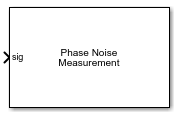Phase Noise Measurement
Compute phase noise at specific frequency offset vectors
Libraries:
Mixed-Signal Blockset /
PLL /
Measurements & Testbenches
Description
The Phase Noise Measurement block measures and plots the phase noise profile for a time domain signal. It also displays the phase noise values for the specified frequency offset vector on the icon of the block.
Ports
Input
Parameters
Algorithms
The Phase Noise Measurement block uses the zero crossing points of a signal
to measure the phase noise. From the zero crossing points, the phase error (φ)is extracted
both at the rising and falling edge of the signal. The captured phase error is used to
generate a periodic signal (sin(φ)). This periodic signal is interpolated using a fixed time step proportional
to the maximum phase noise frequency offset. The power density of the modified phase noise
signal, using the dsp.SpectrumEstimator
System object, directly provides the phase noise profile of the signal of interest.
Version History
Introduced in R2019a
